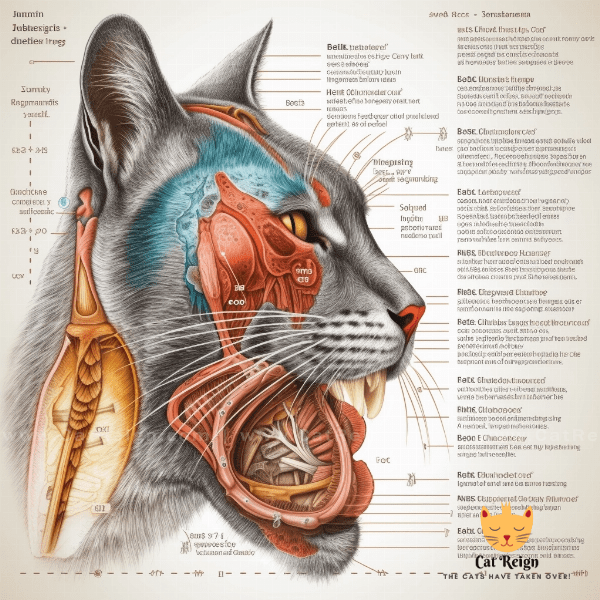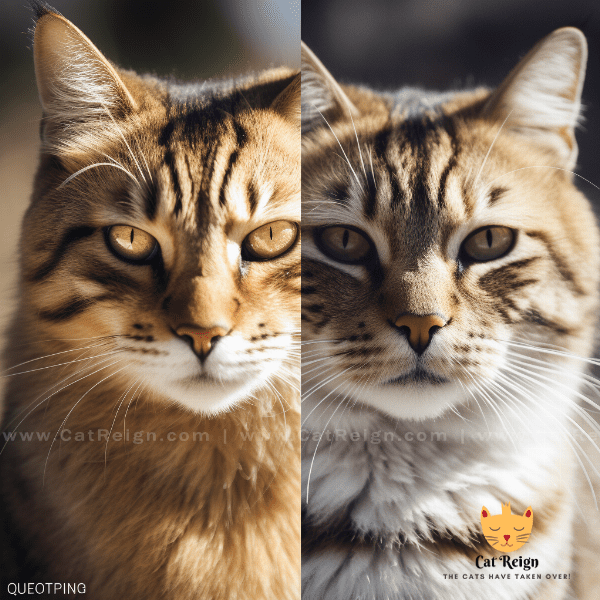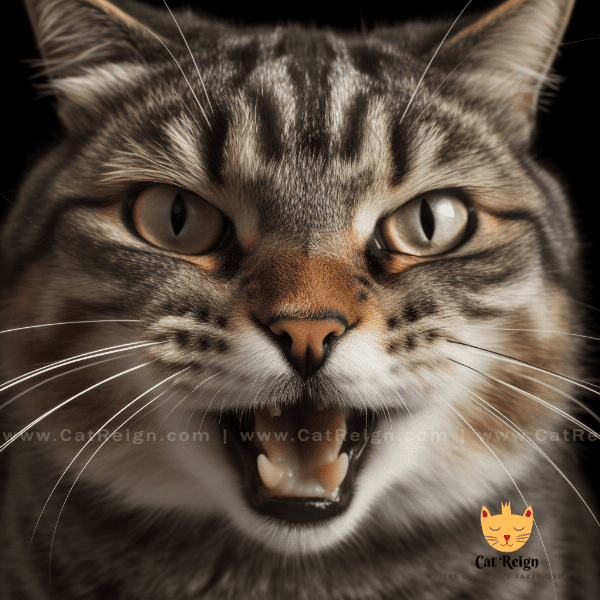Table of Contents
- The Science Behind Cat Purring
- Health Benefits of Listening to Cat Purring
- The Evolution of Cat Purring
- How Cats Use Purring to Communicate
- Common Misconceptions About Cat Purring
- The Different Types of Cat Purrs and What They Mean
- Purring in Domestic Cats vs. Wild Cats
- Techniques for Encouraging Your Cat to Purr
- The Calming Effect of Cat Purring on Humans
- Conclusion: The Enduring Allure of Cat Purring
The Science Behind Cat Purring
Cat purring is a unique phenomenon that has fascinated humans for centuries. Scientists have been studying the science behind cat purring to understand why and how cats purr. Here are some of the key findings about cat purring.
How Cats Purr
Purring is a complex process that involves the coordination of various body systems. When cats purr, they use their larynx and diaphragm muscles to produce a continuous sound that is usually between 25 and 150 Hertz. As the cat inhales and exhales, the vocal cords vibrate, creating the purring sound.
Why Cats Purr
While we often associate purring with a cat’s contentment, it turns out that cats also purr when they’re in pain, anxious, or frightened. Research suggests that purring may be a way for cats to self-soothe and reduce stress.
The Healing Power of Cat Purring
Studies have shown that the frequency of cat purring can have healing effects on the human body. The vibrations produced by purring can improve bone density and promote healing of soft tissues. Purring has also been found to lower blood pressure and reduce stress, making it an effective therapy for people with hypertension or anxiety disorders.
Purring and Cat Communication
Cats use purring as a means of communication with their owners and other cats. While we may not understand the nuances of a cat’s purring, studies have found that the frequency and intensity of a cat’s purr can convey different meanings. For example, a low-pitched purr may indicate contentment, while a higher-pitched purr may indicate discomfort or pain.
Cat Purring in the Wild
In conclusion, cat purring is a fascinating subject that has captivated the attention of scientists and cat lovers alike. While we may never fully understand the complexities of cat purring, research has shown that it has numerous benefits for both cats and humans. Whether you’re a cat owner or simply a fan of felines, the science behind cat purring is sure to leave you purring with delight.

Health Benefits of Listening to Cat Purring
Listening to a cat purr can have several health benefits for humans. Here are some of the benefits of listening to cat purring.
Lowers Blood Pressure
In addition to reducing stress, listening to cat purring can also lower blood pressure. High blood pressure is a common health problem that can lead to serious complications such as heart disease and stroke. Studies have found that the frequency of cat purring, which is usually between 25 and 150 Hertz, can stimulate the body’s natural healing mechanisms and reduce blood pressure.
Promotes Healing
The vibrations produced by cat purring can promote healing of soft tissues and improve bone density. The frequency of cat purring has been found to be between 20 and 140 Hertz, which is within the range known to promote healing of bones and tissues. Listening to cat purring can help speed up the healing process of injuries and fractures.
Relieves Pain
Listening to cat purring can also help relieve pain. Studies have found that the vibrations produced by cat purring can stimulate the body’s natural pain relief mechanisms and reduce the perception of pain. This is why cats often purr when they’re in pain or distress.
Improves Sleep Quality
Finally, listening to cat purring can improve sleep quality. The soothing sound of cat purring can help people fall asleep faster and stay asleep longer. This can lead to improved overall health and well-being.
In conclusion, listening to cat purring can have several health benefits for humans. From reducing stress and anxiety to promoting healing and relieving pain, the soothing sound of cat purring can have a positive impact on our physical and mental health. So the next time you hear your cat purring, take a moment to listen and enjoy the many benefits it has to offer.

The Evolution of Cat Purring
The origins of cat purring are shrouded in mystery, but scientists have been able to piece together some of the evolutionary history behind this fascinating phenomenon. Here are some of the key findings about the evolution of cat purring.
Origins of Cat Purring
Cat purring is believed to have originated from a sound that kittens make when they nurse. This sound is called a “murmur” and is produced by the vibration of the laryngeal muscles. Over time, this sound evolved into the purring we know today.
The Genetics of Purring
The ability to purr is a genetic trait that is specific to the cat family. Not all cats can purr, however. For example, while domestic cats, lions, and tigers can purr, cheetahs and cougars cannot. The reason for this is due to differences in their larynx and hyoid bone anatomy.
The Benefits of Purring
Purring has several benefits for cats, including promoting healing and reducing stress. However, it is not clear why cats have evolved the ability to purr. Some scientists believe that purring evolved as a way for mother cats to communicate with their kittens, while others believe that it evolved as a way for cats to self-soothe.
Purring and Domestication
Finally, some scientists believe that the ability to purr played a role in the domestication of cats. Domestic cats are more social and less aggressive than their wild counterparts, and it is possible that the ability to purr helped cats to communicate and bond with humans.
In conclusion, the evolution of cat purring is a fascinating subject that has captured the attention of scientists and cat lovers alike. While we may never fully understand why and how cats purr, research has given us a glimpse into the evolutionary history of this unique phenomenon. From the origins of purring in nursing kittens to the genetics of purring and its role in domestication, the evolution of cat purring is a story that continues to unfold.

How Cats Use Purring to Communicate
Contentment and Happiness
The most common reason cats purr is to indicate contentment and happiness. When a cat is feeling relaxed and comfortable, it will often purr as a way to express its pleasure. This type of purring is typically low-pitched and rhythmic, and can often be accompanied by kneading or head-butting.
Self-Soothing
Cats also purr as a way to self-soothe when they’re feeling anxious or stressed. The vibrations produced by purring have a calming effect on cats, and can help them feel more relaxed and secure. This is why cats often purr when they’re in stressful situations, such as when they’re at the vet or in a new environment.
Healing and Recovery
Purring has been found to have healing properties, and cats may use purring to promote healing and recovery from injury or illness. The vibrations produced by purring can stimulate the body’s natural healing mechanisms, and may help to reduce inflammation and pain.
Social Bonding
Cats also use purring as a way to bond with their owners and other cats. Purring is a non-threatening sound that can help cats to feel more comfortable and relaxed around each other. When cats purr together, it can be a sign of social bonding and a way to strengthen their relationships.
Requesting Attention or Food
In conclusion, cats use purring as a way to communicate with their owners and other cats. From expressing contentment and happiness to self-soothing and promoting healing, the many different ways cats use purring to communicate is a testament to their unique and fascinating nature. So the next time your cat purrs, take a moment to appreciate the many messages it may be trying to convey.

Common Misconceptions About Cat Purring
Cat purring is a fascinating subject that has captured the attention of cat lovers and scientists alike. However, there are also several misconceptions about cat purring that have persisted over time. Here are some of the most common misconceptions about cat purring.
Myth: Cats Only Purr When They’re Happy
One of the most persistent myths about cat purring is that cats only purr when they’re happy. While purring is often a sign of contentment, cats also purr when they’re in pain, anxious, or frightened. Purring is a self-soothing mechanism that cats use to reduce stress, and can be a sign of a variety of emotions.
Myth: Only Domestic Cats Purr
Another common misconception is that only domestic cats purr. In reality, many wild cats such as lions and tigers also purr. While the purring of big cats is less well understood than that of domestic cats, it is believed that they use purring as a way to communicate with other cats and to express their emotions.
Myth: All Cats Can Purr
While many cats can purr, not all cats have the ability to do so. For example, cheetahs and cougars cannot purr because of differences in their larynx and hyoid bone anatomy. Additionally, some cats may have a medical condition that prevents them from purring.
Myth: Purring is Always a Sign of Contentment
While purring is often a sign of contentment, it can also be a sign of pain or discomfort. Cats may purr when they’re in pain or anxious as a way to self-soothe. If your cat is purring excessively or in unusual situations, it may be a sign that something is wrong.
Myth: Cats Only Purr When They’re Young
Finally, some people believe that cats only purr when they’re young. In reality, cats can purr throughout their entire lives. In fact, some cats may purr more frequently as they get older and become more attached to their owners.
In conclusion, there are several common misconceptions about cat purring that have persisted over time. While purring is often a sign of contentment, it can also be a sign of a variety of emotions. Additionally, not all cats have the ability to purr, and some may purr more frequently as they get older. By understanding the facts about cat purring, we can better appreciate this unique and fascinating aspect of feline behavior.

The Different Types of Cat Purrs and What They Mean
Cats are known for their vocalizations, and purring is one of the ways they communicate with each other and with humans. While purring is often associated with contentment, cats use different types of purrs to convey different messages. Here are some of the different types of cat purrs and what they mean.
Contentment Purring
Contentment purring is the most common type of purring, and is typically associated with a relaxed and happy cat. Contentment purring is usually low-pitched and rhythmic, and can be accompanied by kneading or head-butting. When a cat is content, it may also have relaxed body language and a slow blinking rate.
Pain or Stress Purring
Pain or stress purring is a type of purring that is often associated with cats that are in pain, anxious, or frightened. This type of purring is usually higher-pitched and more sporadic than contentment purring, and may be accompanied by other signs of distress such as panting or hiding. If your cat is purring in unusual situations or excessively, it may be a sign that something is wrong.
Hunger or Request Purring
Hunger or request purring is a type of purring that is used by cats to request food or attention. This type of purring may sound similar to contentment purring, but may be higher-pitched and more insistent. If your cat is purring and rubbing against you or meowing, it may be trying to get your attention or asking for food.
Greeting Purring
Greeting purring is a type of purring that cats use to greet their owners or other cats. This type of purring may be accompanied by other signs of affection such as head-butting or rubbing against the person or cat. Greeting purring is usually low-pitched and rhythmic, and can be a sign that the cat is happy to see you.
Mothering Purring
Mothering purring is a type of purring that mother cats use to communicate with their kittens. This type of purring is usually soft and gentle, and may be accompanied by licking or grooming. Mothering purring can be a sign that the mother cat is trying to comfort or bond with her kittens.
In conclusion, cats use different types of purrs to communicate with their owners and other cats. By understanding the different types of purrs and what they mean, we can better understand our cats’ behavior and respond appropriately to their needs. So the next time your cat purrs, take a moment to listen and see what message it may be trying to convey.

Purring in Domestic Cats vs. Wild Cats
Cats are known for their vocalizations, and purring is one of the ways they communicate with each other and with humans. While domestic cats and wild cats both purr, there are some differences in how and why they purr. Here’s a closer look at purring in domestic cats vs. wild cats.
Domestic Cats
Domestic cats are the most common type of cat, and they are known for their affectionate and social behavior. Domestic cats purr in a variety of situations, including when they’re content, anxious, or in pain. Domestic cats usually purr in a low-pitched and rhythmic manner, and may be accompanied by other signs of affection such as kneading or head-butting.
Wild Cats
Wild cats, such as lions and tigers, also purr, but their purring behavior is less well understood than that of domestic cats. Wild cats cannot roar because their larynx is not as flexible as that of domestic cats, and it is believed that they use purring as a way to communicate with other cats and to express their emotions.
Differences in Purring Mechanism
While domestic cats and wild cats both purr, there are some differences in how they produce the purring sound. Domestic cats produce the purring sound by contracting and relaxing their laryngeal muscles at a frequency of 25 to 150 Hertz. Wild cats, on the other hand, produce the purring sound by contracting and relaxing their hyoid bone, which is located in the neck.
Differences in Purring Function
The function of purring in domestic cats and wild cats may also differ. Domestic cats use purring as a way to communicate with their owners and other cats, and may purr in a variety of situations. Wild cats, on the other hand, may use purring as a way to communicate with other cats and to express their emotions, but the exact function of purring in wild cats is less well understood than that of domestic cats.
In conclusion, while domestic cats and wild cats both purr, there are some differences in how and why they purr. Domestic cats purr in a variety of situations and use purring as a way to communicate with their owners and other cats. Wild cats, on the other hand, use purring as a way to communicate with other cats and to express their emotions, but the function of purring in wild cats is less well understood. By understanding the differences in purring behavior between domestic cats and wild cats, we can better appreciate the unique and fascinating nature of feline behavior.

Techniques for Encouraging Your Cat to Purr
Cats are known for their purring, and the sound of a cat’s purr can be soothing and relaxing for both the cat and its owner. If you want to encourage your cat to purr, there are several techniques you can try. Here are some of the best ways to encourage your cat to purr.
Provide Comfortable and Secure Environment
Cats are more likely to purr when they feel relaxed and comfortable, so providing a comfortable and secure environment is key to encouraging purring. Make sure your cat has a comfortable bed to sleep in and plenty of toys to play with. You can also create a cozy hiding spot for your cat to retreat to when it feels stressed or anxious.
Pet and Stroke Your Cat
Petting and stroking your cat can also encourage purring. Cats often purr when they’re feeling content and relaxed, and petting your cat can help to create this feeling. When you pet your cat, focus on areas that your cat likes, such as behind the ears or under the chin.
Play Soothing Music
Playing soothing music can also help to encourage your cat to purr. Cats have been found to be more relaxed and less anxious when they’re exposed to calming music. You can experiment with different types of music to find out what your cat responds to best.
Offer Treats or Food
Another way to encourage your cat to purr is to offer treats or food. Many cats will purr when they’re happy and content, and food can be a great way to achieve this. Try offering your cat its favorite treats or food and see if this encourages purring.
Spend Time with Your Cat
Finally, spending time with your cat is one of the best ways to encourage purring. Cats are social animals and enjoy spending time with their owners. By spending quality time with your cat, you can create a bond that will encourage purring and help your cat to feel happy and content.
In conclusion, there are several techniques you can use to encourage your cat to purr. By providing a comfortable and secure environment, petting and stroking your cat, playing soothing music, offering treats or food, and spending time with your cat, you can help to create a relaxed and content atmosphere that will encourage purring. So the next time you want to hear your cat purr, try one of these techniques and see what works best for your furry friend.

The Calming Effect of Cat Purring on Humans
Cats are known for their soothing and relaxing purring, and this sound can have a calming effect on humans as well. In fact, studies have shown that listening to cat purring can have several health benefits for humans. Here’s a closer look at the calming effect of cat purring on humans.
Lowers Blood Pressure and Heart Rate
Another benefit of listening to cat purring is that it can lower blood pressure and heart rate. The sound of cat purring has a soothing effect on the body, which can help to relax the muscles and lower blood pressure. This can be beneficial for people who suffer from high blood pressure or other cardiovascular conditions.
Promotes Relaxation and Sleep
Listening to cat purring can also promote relaxation and sleep. The sound of cat purring can create a relaxing and calming atmosphere, which can help people to fall asleep faster and sleep more soundly. This can be especially helpful for people who have trouble sleeping or suffer from insomnia.
Provides Emotional Support
Finally, listening to cat purring can provide emotional support for people who are going through difficult times. The sound of cat purring can create a sense of comfort and security, which can help people to feel less alone and more supported. This can be especially helpful for people who are dealing with depression, grief, or other emotional challenges.
In conclusion, listening to cat purring can have several health benefits for humans. It can reduce stress and anxiety, lower blood pressure and heart rate, promote relaxation and sleep, and provide emotional support. So the next time you’re feeling stressed or anxious, try listening to the soothing sound of cat purring and see how it can help you to feel more relaxed and calm.

Conclusion: The Enduring Allure of Cat Purring
Cat purring is a unique and fascinating aspect of feline behavior that has captured the attention of cat lovers for centuries. From the soothing and relaxing sound of a cat’s purr to the different types of purrs and what they mean, there’s no denying the enduring allure of cat purring.
Throughout this article, we have explored the science behind cat purring, the health benefits of listening to cat purring, the evolution of cat purring, how cats use purring to communicate, common misconceptions about cat purring, purring in domestic cats vs. wild cats, techniques for encouraging your cat to purr, and the calming effect of cat purring on humans.
Through these discussions, we have learned that cat purring is not only a way for cats to communicate with each other and with humans, but it also has several health benefits for both cats and humans. We have also discovered that cat purring is a complex behavior that varies depending on the situation and the cat’s emotional state.
In conclusion, cat purring is a fascinating and complex aspect of feline behavior that continues to capture the hearts and minds of cat lovers around the world. By understanding the science behind cat purring and the different types of purrs and what they mean, we can better appreciate the unique and fascinating nature of our feline companions. So the next time you hear your cat purring, take a moment to listen and appreciate the enduring allure of cat purring.




